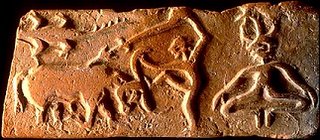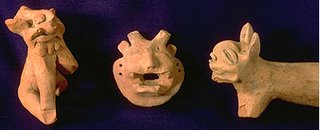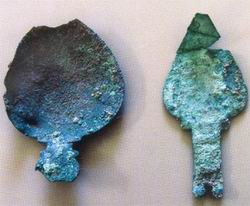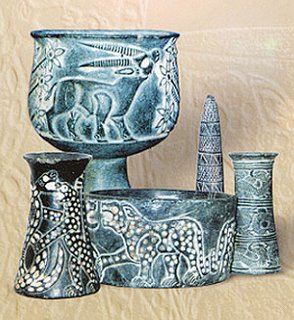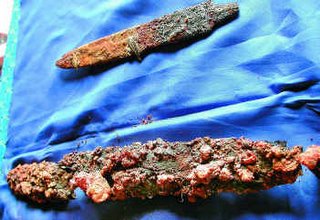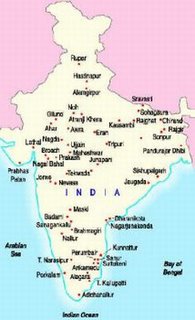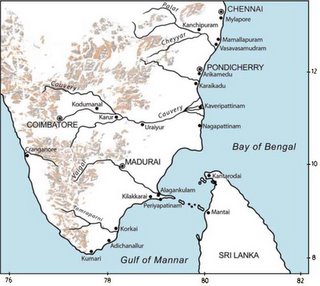Dotted circle and trefoil as Sarasvati hieroglyphs; context: smithy, mintChampollion interpreted a dotted circle as an Egyptian hieroglyph and read the syllabic values associated with the glyph and reading it rebus.
Here is an example illustrating the Egypitian hieroglyphs and rebus readings.
Early hieroglyphs in Egypt were used to keep a record of king’s possessions. A cartouche was used for royal names.
Seeing the name, Champollion thought that first sign sounded like the sun, in Coptic, ``Ra''; he knew from the Rosetta stone that second sign was associated with the words ``to give birth'', ``mose'', so he thought it was the consonant ``m'', and he knew, from Ptolemaic names, that the duplicated glyph was an ``s''. So he got : ``ra-m-s-s'', Ramesses.
http://webperso.iut.univ-paris8.fr/~rosmord/Intro/node9.htmlTrefoil and dotted circles on Sarasvati epigraphs and artefacts
Trefoil and dotted circles are glyphs which occur on Sarasvati hieroglyphs.
A trefoil can be viewed as an artistic styling of a ligature of three dotted circles.
h352C Field Symbol 83 (Dotted circles) 57 out of 67 occur at Harappa
Dotted circles. Field symbol 83 (10) [The tree: ]
ghan:ghar ghon:ghor ‘full of holes’ (Santali); rebus: kan:gar ‘portable furnace (K.)
kut.hi ‘a furnace for smelting iron ore to smelt iron’; kolheko kut.hieda koles smelt iron (Santali) kut.hi, kut.i (Or.; Sad. kot.hi) (1) the smelting furnace of the blacksmith; kut.ire bica duljad.ko talkena, they were feeding the furnace with ore; (2) the name of e_kut.i has been given to the fire which, in lac factories, warms the water bath for softening the lac so that it can be spread into sheets; to make a smelting furnace; kut.hi-o of a smelting furnace, to be made; the smelting furnace of the blacksmith is made of mud, cone-shaped, 2’ 6” dia. At the base and 1’ 6” at the top. The hole in the centre, into which the mixture of charcoal and iron ore is poured, is about 6” to 7” in dia. At the base it has two holes, a smaller one into which the nozzle of the bellow is inserted, as seen in fig. 1, and a larger one on the opposite side through which the molten iron flows out into a cavity (Mundari.lex.) kut.hi = a factory; lil kut.hi = an indigo factory (H.kot.hi)(Santali.lex.Bodding) kut.hi = an earthen furnace for smelting iron; make do., smelt iron; kolheko do kut.hi benaokate baliko dhukana, the Kolhes build an earthen furnace and smelt iron-ore, blowing the bellows; tehen:ko kut.hi yet kana, they are working (or building) the furnace to-day (H. kot.hi_)(Santali.lex.Bodding) kut.t.hita = hot, sweltering; molten (of tamba, cp. uttatta)(Pali.lex.) uttatta (ut + tapta) = heated, of metals: molten, refined; shining, splendid, pure (Pali.lex.) kut.t.akam, kut.t.ukam = cauldron (Ma.); kut.t.uva = big copper pot for heating water (Kod.)(DEDR 1668). gudga_ to blaze; gud.va flame (Man.d); gudva, gu_du_vwa, guduwa id. (Kuwi)(DEDR 1715). da_ntar-kut.ha = fireplace (Sv.); ko_ti wooden vessel for mixing yeast (Sh.); kot.ha_ house with mud roof and walls, granary (P.); kut.hi_ factory (A.); kot.ha_ brick-built house (B.); kut.hi_ bank, granary (B.); kot.ho jar in which indigo is stored, warehouse (G.); kot.hi_ lare earthen jar, factory (G.); kot.hi_ granary, factory (M.)(CDIAL 3546). kot.ho = a warehouse; a revenue office, in which dues are paid and collected; kot.hi_ a store-room; a factory (G.lex.) kod. = the plae where artisans work (G.lex.)
kut.i, kut.hi, kut.a, kut.ha a tree (Kaus'.); kud.a tree (Pkt.); kur.a_ tree; kar.ek tree, oak (Pas;.)(CDIAL 3228).
kut.ha, kut.a (Ka.), kudal (Go.) kudar. (Go.) kut.ha_ra, kut.ha, kut.aka = a tree (Skt.lex.) kut., kurun: = stump of a tree (Bond.a); khut. = id. (Or.)
kut.amu = a tree (Te.lex.)
bali = iron stone sand (Santali) bal = to bore a hole, or to puncture, with a red ho iron (Santali) [Note: the dotted circle may denote rebus: bali ‘iron stone sand’.]
Dotted circles: tamar =hole in a plank, commonly bored or cut; gimlet, spring awl, boring instrument; tavar =to bore, a hole; hole in a board (Ta. tamar =hole made by gimlet)
homa = bison (Pengo); rebus: hom = gold (Ka.); soma = electrum, gold-silver compound ore (RV)
tagara = tavara Tbh. of tamara or trapu = tin (Ka.Te.Ta.Ma.) takaram = tin, white lead (Ta.); tagarm (obl. tagart-) tin (Ko.); tamaru, tamara, tavara id. (Tu.); tagaramu, tamaramu, tavaramu id. (Te.); t.agromi tin metal, alloy (Kuwi); tamara id. (Skt.)(DEDR 3001).
takar sheep, ram, goat (Ta.); tagar ram (Ka.); tagaru (Tu.); tagaramu, tagaru (Te.); tagar (M.)(DEDR 3000).
Glyph of trefoil or three dotted circles: tebr.a ‘three’ + t.a_~ko, t.a_ka, d.a_ga ‘dotted circle’; rebus: tamb(ra) ‘copper’ + d.han:gar ‘smith’; alt. t.an:ka ‘mint, gold’. t.hakkura = idol, deity, title (Skt.); Rajput, chief man of a village (Pkt.); t.ha_kor = god, idol (G.)(CDIAL 5488).
Dotted circle is read as syllable t.ha in Brahmi script. This glyph and corresponding phoneme provides a basis for a hypothesis that the hieroglyphic script of Sarasvati civilization evolved into a syllabic Brahmi script. It is notable that Brahmi is another name for Sarasvati.
Pict-79
Pict-128
Ficus glomerata: loa, kamat.ha = ficus glomerata (Santali); rebus: loha = iron, metal (Skt.) kamat.amu, kammat.amu = portable furnace for melting precious metals (Te.) kammat.i_d.u = a goldsmith, a silversmith (Te.)
kampat.t.tam coinage coin (Ta.);
kammat.t.am kammit.t.am coinage, mint (Ma.);
kammat.a id.;
kammat.i a coiner (Ka.)(DEDR 1236)
Finely burnished gold fillet (headband) with holes at both ends to hold a cord. Each end is decorated with a punctuated design of standard device. 42 x 1.4 cm. Mohenjodaro Museum, MM 1366; Marshall 1931: 220.527. Pl. CXVIII, 14 (for punctuated design)Detail of gold fillet with punctuated design of standard device at both ends of the gold fillet. (After Fig. 7.32, Kenoyer, 1998)
kamarsa_la = waist band; rebus: kamarsa_la ‘workshop of smith’ (Te.) [The pannier is an emphatic ligatured glyph on a one-horned bull.] damra = heifer, young bull, steer (G.); rebus: tambra = copper (Skt.) Rebus: damad.i_ (H.) damr.i, dambr.i = one eighth of a copper pice (Santali) The depiction of the ligatured heifer with a pannier is thus a hieroglyph read rebus: damr.i ‘copper’; kamarsa_la ‘smithy workshop’. This is further reinforced by the curved one horn. Kod. ‘horn’; kod. ‘workshop’.
MIC, Pl. CLVIII,1. Pin-head with a deer motif and dotted circles on the body.
pasra = smithy (Santali) pisera_ = a small deer brown above and black below (H.)(CDIAL 8365). pr.s.ata = spotted; spotted deer (VS.); pr.s.ita = spotted (n. ‘rain’ Gobh.); pr.s.at = spotted (AV); spotted antelope (R.); pasata-miga = spotted deer (Pali); pasaya = a kind of deer (Pkt.); pusia id. (Pkt.)(CDIAL 8364). paha_ru (P.); pa_hr.a_ = stag (P.) pa_ri_ (G.), paha_r, paha_ray (M.) Spotted antelope pa_r.ho hogdeer or cervus porcinus (S.); pa_hr.a_ (L.); pa_r.ha_ = spotted antelope, hogdeer (P.H.) pr.s.ata = spotted deer (VS.)
po_tramu = snout of a hog; po_tri = a hog; a boar (Te.)
Slide 45. Seated male.
Seated male figure with head missing (45,
46). On the back of the figure, the hair style can be partially reconstructed by a wide swath of hair and a braided lock of hair or ribbon hanging along the right side of the back. A cloak is draped over the edge of the left shoulder and covers the folded legs and lower body, leaving the right shoulder and chest bare. The left arm is clasping the left knee and the hand is visible peeking out from underneath the cloak. The right hand is resting on the right knee which is folded beneath the body. Material: limestone Dimensions: 28 cm height, 22 cm widthMohenjo-daro, L 950 Islamabad Museum Marshall 1931:358-9, pl. C, 1-3
Slide 41. "Priest King."
Seated male sculpture, or "Priest King" from Mohenjo-daro (41,
42, 43). Fillet or ribbon headband with circular inlay ornament on the forehead and similar but smaller ornament on the right upper arm. The two ends of the fillet fall along the back and though the hair is carefully combed towards the back of the head, no bun is present. The flat back of the head may have held a separately carved bun as is traditional on the other seated figures, or it could have held a more elaborate horn and plumed headdress. Two holes beneath the highly stylized ears suggest that a necklace or other head ornament was attached to the sculpture. The left shoulder is covered with a cloak decorated with trefoil, double circle and single circle designs that were originally filled with red pigment. Drill holes in the center of each circle indicate they were made with a specialized drill and then touched up with a chisel. Eyes are deeply incised and may have held inlay. The upper lip is shaved and a short combed beard frames the face. The large crack in the face is the result of weathering or it may be due to original firing of this object. Material: white, low fired steatite Dimensions: 17.5 cm height, 11 cm width Mohenjo-daro, DK 1909 National Museum, Karachi, 50.852 Marshall 1931: 356-7, pl. XCVIII
t.hakkura = idol, deity, title (Skt.); Rajput, chief man of a village (Pkt.); t.ha_kor = god, idol (G.)(CDIAL 5488).
Dotted circle is read as syllable t.ha in Brahmi script. This glyph and corresponding phoneme provides a basis for a hypothesis that the hieroglyphic script of Sarasvati civilization evolved into a syllabic Brahmi script. It is notable that Brahmi is another name for Sarasvati.
Three dotted circles appear on the robe of the sculpture in the round of a ‘robed priest’. A dotted circle is also depicted as the eye of a fish or hare (Fish: H-329, H-330 and Hare: H-335).
tamar = counselors, men guiding one’s affairs: tammir- periya_r tamara_ vor..ukutal :(Kur-al. 444); tamar = servants (teva_ 907.1); tamar = relations, kindred (Ta.Ka.Ma.); friends, well-wishers (Pur-ana_. 157); tamarmai = friendship (Ta.); tamal. A female relative or friend (Ta.); taman- = a male relative or friend: cu_l.a_. araci. 182); tavan- < tapas = ascetic (Periyapu. Pura_n.aca_. 22); tavan- = religious austerity (Ta.lex.) tamaru (collo. pl. of ni_vu) you: used in respectful or polite address or to persons of higher station (Te.lex.) tavattar = ascetics; tavam < tapas = penance, religious austerities : Kur-al. 266 (Ta.) tameru, tamar, tamari, tamare = one who gives a bride away in marriage; a guardian (Tu.lex.) ta_mbu themselves (Kuwi); tamaru they, themselves (Kol.); ta_vu (Ka.); tamar = one’s own people, relatives (Ta.)(DEDR 3162).tabe = dependent, subject; tabedar = a dependent, a follower, a subject; taben = your (dual); tabol, tabon = ours, our, belonging to us (inclusive of person addressed)(Santali.lex.)
Priest: tammad.a, tammad.i = an attendant on an idol (Ka.); tammal.ava_d.u, tammal.i, tammad.i, tammali, tambal.ava_d.u (Te.) Rebus: tamba = copper (Santali) tamire = hole; t.ebra = three (cf. glyph of trefoil inlaid on the uttari_yam – upper garment); Rebus: tamara = tin (Ka.)
Cloak, trefoil glyph: got.a_ a garment with clusters of flowers woven in it; got.a_kor [+ kor a border] a border of a garment having clusters of flowers woven in it; got.iyum a piece of cloth made use of in making up a turban to give it a round shape (G.) go_t.u embroidery, lace (Tu.); go~_t.u an ornamental appendage to the border of a cloth, fringe, hem, edging (Te.); got. Hem of garment; got.a_ edging of gold lace (H.)(DEDR 2201). go_t.u = an ornamental appendage to the border of a cloth, fringe, hem, edging (Te.); embroidery (Tu.) kont.l.= pocket in outside edge of cloak (Ko.); got. = hem of garment (M.); got.a_ = edging of gold lace (H.) got. hem of a garment, metal wristlet (M.); got.t.a_ gold or silver lace (P.)(CDIAL 4271).
ko_t.u = line (Ta.) kod.a = 4 gan.d.a. kod.a = one in arithmetic. got.a = numerative particle (Mth.) kot.i_ the largest bead in a rosary from which the counting begins (G.)
got.i_ = a lump of silver (G.lex.)
kod., ‘artisan’s workshop’ got.h, got. ‘assembly’ (Santali) got. = the place where cattle are collected at mid-day (Santali); gos.t.ha (Skt.); kod. = place where artisan’s work (Kur.); cattle-shed (Or.) kod. = a cow-pen; a cattlepen; a byre (G.lex.) gor.a = a cow-shed; a cattlepsed; gor.a orak = byre (Santali.lex.) got.ho [Skt. kos.t.ha the inner part] a warehouse; an earthen vessel in wich indigo is stored (G.lex.) kot.t.amu = a stable (Te.lex.) Substantive: got.h, got. Place where cattle are assembled (Santali)
It may be hypothesized that the ‘trefoil’ glyptic motif is related to this lexeme, tebr.a ‘thrice, three times’. tagad.o [Skt. trika, a group of three] the figure three (G.lex.) t.haba t.hobo = in a cluster, applied to fruit (Santali); rebus: t.habu t.habu = large, big, very big (Santali). tamba = copper (Santali)
Thus, the ‘trefoil’ motif may be read as: tebr.a kan:ghar ‘copper [ta(m)bra] furnaces’. tibira = copper merchant (Akkadian). The ‘priest-king’ statuette adorned with a uttari_yam (angarkha, drape) with ‘trefoil’ embroidery is an apparent rebus representation of a very big copper merchant.
Standard device. Centre: carved in ivory (HR 93-2092) flanked by device depicted on faience tablets (HR 90-1687, H93-2051), Harappa
Processional scene from a terracotta tablet. After Marshall 1931, Pl. CXVIII,9
Bull with trefoil inlays; statue, Uruk (W.16017), c. 3000 BCE; shell mass with inlays of lapis lazuli; 5.3 cm. long; Vorderasiatisches Museum, Berlin; Parpola, 1994, p. 213.
Trefoil-decorated bull; traces of red pigment remain inside the trefoils. Steatite statue fragment; Mohenjodaro (Sd 767);. After Ardeleanu-Jansen 1989: 196, fig. 1; Parpola, 1994, p. 213.
Trefoils painted on steatite beads, Harappa (After Vats, Pl. CXXXIII, Fig.2)
Tre-foil inlay decorated base (for s’iva linga); smoothed, polished pedestal of dark red stone; National Museum of Pakistan, Karachi; After Mackay 1938: I, 411; II, pl. 107:35; Parpola, 1994, p. 218.
Two decorated bases and a lingam, Mohenjodaro.
Lingam, grey sandstone in situ, Harappa, Trench Ai, Mound F, Pl. X (c) (After Vats). "In an earthenware jar, No. 12414, recovered from Mound F, Trench IV, Square I... in this jar, six lingams were found along with some tiny pieces of shell, a unicorn seal, an oblong grey sandstone block with polished surface, five stone pestles, a stone palette, and a block of chalcedony..." (Vats, EH, p. 370).
ta_varam = lingam; ta_vara-lin:kam = lingam set up in tables for general worship; ta_varan- = God (Ta.lex.) tambal.a = a certain caste among s’u_dra, who are worshippers of S’iva and are priestlings in temples; tambal.i = a man of the tambal.a caste (Te.lex.) tammad.i = an attendant on an idol (Ka.); tambal.ava_d.u, tammal.a, tammad.i, tammali, tammal.ava_d.u (Te.)(Ka.lex.) tagidar = an overseer (Santali.lex.)
Dotted circles betwixt standard device on a tablet
8093a.
Image: to perforate; center: bhog the centre, the middle; bhogtetre ubpe empty in the center (Santali.lex.) bogoc to make a hole in, to open, to slit; pin.d.hako bogockeda they cut the dam; bhugak, bhuk a hole, an opening, a cave; bha~ora bhugak a window opening, an opening to admit light (Santali.lex.) bhokvum. to pierce; to perforate; to bore; to puncture; to drive in or through; to stab; bhok a perforation, a hole; a bore; bhoka_vu hollowness; emptiness (G.lex.) bon:ku
adj. hollow, empty; bon:g hollow inside; boga_ri copper-smith (Tu.lex.) bokko, bokkea_ blister, pustule (Kon.lex.)
Nd-3t Navdatoli tablet
(image placeholder)h855At(image placeholder)h855Bt(image placeholder)h855Ct
(image placeholder)Kalibangan057(image placeholder)Kalibangan058(image placeholder)m1259
(image placeholder)m1260(image placeholder)h974Ait(image placeholder)h974Bit(image placeholder)h974Cit (image placeholder)4592
(image placeholder)h978Ait(image placeholder)h978Bit(image placeholder) h978Cit (image placeholder)5412
(image placeholder)h888Abit(image placeholder)4466(image placeholder)h889Abit(image placeholder)5477
(image placeholder)h832At(image placeholder)h832Bt Tablet in bas-relief (image placeholder)h638
(image placeholder) h352A(image placeholder) h352B(image placeholder) h352C (image placeholder)4575 Pict-120: One or more dotted circles. [54 out of 67 objects on which this glyph occur, are miniature tablets]
The text on top line occurs mainly on miniature tablets of Harappa over 46 times.
Top line of text 4575; third sign from left: Glyph, comb kangha (IL 1333) ka~ghera_ comb-maker (H.)
Rebus, substantive: kan:g = brazier, fireplace (K.)(IL 1332) Portable brazier; ka~_guru, ka~_gar (Ka.) whence, large brazier = kan:gar (K.)
(image placeholder)h353A(image placeholder)h353B(image placeholder)h353C (image placeholder)5416
(image placeholder)h354A(image placeholder)h354B(image placeholder)h354C (image placeholder)5499
(image placeholder) h359a(image placeholder) h359B(image placeholder) h359C
(image placeholder)h361A(image placeholder)h361B(image placeholder)h361C (image placeholder)5476
(image placeholder)h362A(image placeholder)h362B(image placeholder) h362C (image placeholder)5466
(image placeholder)h365A(image placeholder)h365B(image placeholder)h365C(image placeholder)h365E
(image placeholder)h367A(image placeholder)h367B(image placeholder) h367C(image placeholder)h367E(image placeholder)4401
(image placeholder)Tablet in bas-relief, Mohenjodaro m490: insignia carried in procession: standard, unicorn, ?pennant +?
Styles and structure of the standard and the top portion (cage?); cf. Mahadevan 1984: 185; Rissman 1989: 162
The top portion resembles a drill-lathe and a drill-head (gimlet). The wavy lines inscribed are a stylised depiction of 'turning motion' of the lathe. The style depicted as G is related to the practice of inserting the upper pivot of the drill-head into a coconut-shell; see below.
Phtanite drill-heads from the surface of MNSE area, Moenjodaro (Massimo Vidale, 1987, p. 147).
(image placeholder)h098(image placeholder)4256 Pict-122 Standard device which is normally in front of a one-horned bull.
(image placeholder)h228A(image placeholder)h228B Standard device which is normally in front of a one-horned bull. The device is flanked by columns of dotted circles. 19 out of 19 occur at Harappa. [See h225 to h228].
(image placeholder)h292A(image placeholder)h292B(image placeholder)m4443 Standard.
(image placeholder)h293A(image placeholder)h293B(image placeholder)4441 Standard.
(image placeholder)h887Ait(image placeholder)h887Bit (Incised tablet) (image placeholder)
m1408At [The standard device is part of the tablet with a text containing four signs.]
m0008a and m0009a [Note the orthography on the device: The top portion ends in a pointed end, shaped like a gimlet [tamiru (gimlet); rebus: tavaru, ‘tin’] has wavy lines indicating churning motion of a lathe: san:gad.a; the bottom portion is ligatured with dotted circles, indicating drilled beads; smoke emanates from the bottom pot held on a rod, indicating it to be a portable furnace: san:gad.a]. Combined with tavaru, the device connotes: tavaru san:gha_ta, (i.e. tin + composite material) alloyed with tin! The bill of materials indicated by the inscription is a list of metal weapons and tools made with tin alloy.
(Note the churning motion using a gimlet and emanating smoke depicted on the upper register of the lathe device and the dotted circles on the bottom vessel; both are mounted on a central 'stele') The dotted circles which appear on the bottom vessel on m008 are also seen on miniature tablets and other inscribed objects.
(image placeholder)h353A(image placeholder)h353B(image placeholder)h353C miniature tablet, incised with 3 dotted circles similar the ones found on the bottom vessel.
[Reconstruction after I. Mahadevan, 1984, pp.165-86]
[Note the 'stele' found in fire-places in Kalibangan, Banawali and Dholavira and other Sarasvati River ancient settlement sites.]
Carved Ivory Standard in the middle har501 Harappa 1990 and 1993: representations of ‘standard device’ a. faience token (top portion ends in a sharp edge like a gimlet); b. standard device (top portion has cross-hatches, perhaps to denote a churning motion; the bottom portion has dotted-circles, perhaps to denote perforation using a gimlet); c. faience token. “Although this object is split in half, it was clearly made on a lathe and probably was cylindrical in shape. The top of the object is finished and incised with a circle motif, while a broken spot on the lower portion indicates where the stand shaft would have been.” [From Richard H. Meadow and Jonathan Mark Kenoyer, Harappa Excavations 1993: the city wall and inscribed materials, in: South Asian Archaeology ; Fig. 40.11, p. 467. Harappa 1990 and 1993: representations of 'standard'; 40.11a: H90-1687/3103-1: faience token; 40.11bH93-2092/5029-1: carved ivory standard fragment (split in half, made on a lathe and was probably cylindrical in shape; note the incisions with a circle motif while a broken spot on the lower portion indicates where the stand shaft would have been (found in the area of the 'Mughal Sarai' located to the south of Mound E across the Old Lahore-Multan Road); 40.11c H93-2051/3808-2: faience token]
A stylized standard device? san:gad.a, ‘portable furnace’.
Hundreds of orthographic representations match this description of this ligatured device. See for example m0021, m0029, m0035
(image placeholder)m0021a (image placeholder)2103
(image placeholder)m0029a(image placeholder)2033
Pict-123 (image placeholder) Standard device which is normally in front of a one-horned bull. The device is flanked by columns of dotted circles.
Glyph: khan:ghar, ghan:ghar, ghan:ghar gon:ghor ‘full of holes’ (Santali)
Substantive: kan:g = brazier, fireplace (K.)(IL 1332) Portable brazier ka~_guru, ka~_gar (Ka.) whence, large brazier = kan:gar (K.)
(image placeholder)Rupar1A(image placeholder)Rupar1B (image placeholder)9021
Dotted circles appear on all sides of a seal or tablet (for e.g., M-352, M-1256, M-1260, H-128) or get inscribed on the ‘cult object’.
(image placeholder)h353C miniature tablet, incised with 3 dotted circles similar the ones found on the bottom vessel.
Dotted circles also adorn inscribed ivory objects.
Kalibangan, Ivory comb with three dotted circles; Kalibangan, Period II; Thapar 1979, Pl.XXVII, in: Ancient Cities of the Indus.
After Vats, Pl.CXIX,.No.6 An ivory comb fragment with one preserved tooth and ornamented with double incised circles (3.8 in. long).
h1017ivorystick
(image placeholder)4561 (image placeholder)(image placeholder)(image placeholder)Ivory rod, ivory plaque with dotted circles. Mohenjodaro. [Musee National De Arts Asiatiques Guimet, 1988-1989, Les cites oubliees de l’Indus Archeologie du Pakistan.]
(image placeholder)m1651Aivory stick(image placeholder) m1651D ivory stick(image placeholder)
m1651F ivory stick(image placeholder)2947(image placeholder)m1652A ivory stick(image placeholder) m1654A ivory cube(image placeholder)m1654B ivory cube(image placeholder)m1654D ivory cube
Amulet (?) Sonkh, Mathura, early 3rd cent. BCE.Bone. 5.7X3.4 cm. (MIK I 3242). The dotted circles are a motif dominant in inscribed objects of the civilization. The motif occurs on ivory objects and also on the 'standard device' in front of the 'one-horned heifer bull'. Elsewhere, it has been interpreted as, 'd.ha_l' connoting a shield; it is natural that this symbolism gets perpetuated on a 'protective device' such as an amulet made of bone. "Cracks at the tip of this plaque indicate that this object has only been preserved in a rather fragmentary condition... A comparison with a piece from Prabhas Patan (Gujarat) which is relatively intact leads to the conclusion that this amulet represents the torso of a human, possibly female, figure. Originally, there must have been two horizontally stretched arms attached to the top of this torso as well as an inverted triangle which represented the face of the figure (see Ghosh 1957: 17 to pl. XVIII B5 and comp. Ghosh 1956: 14 to pl. XXIV B; see also Dwivedi 1976: 55f. and 59). Incised on the polished front side of the plaque there are parallel lines arranged in horizontal and diagonal patterns, as well as five circles, each with a dot in the centre. On the plaque from Prabhas Patan similar motifs were applied to suggest eyes (perhaps also a nose or a mouth), breasts and fingers. The remaining incisions, as seen on this fragment from the Museum of Indian Art, Berlin, may not be indicative of anything in particular: their purpose appears to be decorative -- to create a harmonious design. The workmanship with its uniform execution and sharp edged cuts reveals a high degree of precision... simple lines-and-circles... Identical workmanship is apparent on relics of the Indus Valley Civilization (Marshall 1931: pl. CXXXII; Mackay 1937-38 pl. CXXV, CXXVIII, CXLIII; Vergessene Stadte am Indus Fruhe Kulturen in Pakisttan 1987: fig. 107). The dating of this particular piece is established from the stratum where it was found in the excavation site at Sonkh (Haertel 1993: 277)." (Heino Kottkamp, Exhibit 1 in: Saryu Doshi, ed., 1998, Treasures of Indian Art: Germany's tribute to India's cultural heritage, Delhi, National Museum, p.19).
Finds at Altyn-depe: ivory sticks and gaming pieces (?) obtained from Sarasvati Sindhu civilization; similar objects with dotted circles found in Mohenjodaro and Harappa.
Bhagawanpura is a site located on the right bank of the River Sarasvati_ in Dist. Kuruks.etra. Remains of semi-circular huts leaving behind only post-holes and rammed floors have been found. From Period IB levels bones of true domesticatd horse, equus caballus have been found. Intersecting dotted circle designs are found on pottery of Painted Grey Ware which overlap the Late Harappan ware.
Mohenjo-daro. Dotted circle decoration on a steatite bowl (DK 3178), DK-B, house 3, room VIII (Jansen and Urban, 1985, RTWH, Aachen).
Vessel fragments with dot-in-circle design from Susa. Louvre Museum. At the Royal Cemetery of Ur, Woolley 1934: 558-59 found a small container with a narrow neck and sides decorated with three dot-in-circle designs.
Terracotta female adorned with 'dotted circles'; Period Namazga II; Yalangach Tepe, Geoksyur (Weiner, 1984, Fig. 183)
khan.d.i = a sar.i, a full dress for a woman, a piece of cloth twelve cubits long by two in width; khan.d.a = a piece of cloth suitable for the dress of a woman’s sar.i; khan.d.i bande, bande = to dress, of women binding round waist (Santali) kola ‘woman’ (Nahali); rebus: kol ‘pancaloha, alloy of five metals’ (Ta.); kollan ‘smith’ (Ta.)
(image placeholder)(image placeholder)
All the orthographic contexts in which the dotted circle and the trefoil motifs are inscribed can be explained with reference to the sememe: d.a_~ga (r) [d.a_ga ‘a mark put on cattle with red-hot iron’] [Semantics: bull, thigh/leg of a seated woman (kola ‘woman’; rebus: kol ‘metal’), idol (t.hakkura), head-man, smith (d.han:gar), eye of ram (dotted circle: me~t ‘eye’ + t.agar ‘ram’ = me~r.he~t ‘iron’ + tagar ‘tin’), eye of fish (dotted circle: a~s ‘scale of fish’+ d.han:gar = rebus ayas + d.han:gar = metal smith), dotted circle on a portable (gold) furnace]
Hence, the ligaturing of ‘dotted circle’ glyph on: the hip of a bull, on the shawl of a statuette of a person (head-man), on the hip/leg of a seated woman. Hence, the ligaturing of ‘trefoil’ on the back of a bull, on the shawl of a statuette of a head-man statuette, on a pedestal to install s’iva lin:ga.
(image placeholder)
MIC, Pl. CXXXII. Needles, awls, handles and objects of ivory bone. Dotted circles on ivory (Items 13, 39, 42, 45). Item 10 has a warrior pictograph which becomes a sign.
There is evidence for the continued use of Sarasvati hieroglyphs (e.g dotted circles) during the historical periods.
Dagger-shaped pendant, ivory, Taxila, 4th-3rd centE. BC: 4.8 cms. One one side of the blade there are decorations of deeply cut parallel lines and two dotted circles. The obverse is plain. The handle has a small hole for suspension (After Taxila, III, pl. 199, no. 14). Most pendants of bone or ivory found are dagger-shaped pendants. Two such specimen are assigned to the Bhir mound. (After Taxila, II, p.654; III, pl. 199, nos. 13 and 14). Other specimen are from Sirkap and Hathial (ibid., nos. 15,16). A dagger-shaped pendant made of bone measures 4.7 cm. One side is incised with six dotted-circles on the handle and on the blade. The handle has a hole for suspension. (ibid., no. 13).
Devices on punch-marked coins (standard device and dotted circle)
Bent bar coin with a central circle and seven radii.
Devices on punch-marked coins (including dotted circle with rays and a dotted circle with six ligatures – 3 of ficus leaf and 3 of rim of short-necked jar. Kan.d.a kanka = rim of jar; rebus: kan.d. = fire altar; kamad.ha ‘ficus’; rebus: kampat.t.am = mint.)
(image placeholder)
Ujjain copper coin with devices paralleling Sarasvati hieroglyphs (Obverse and reverse)
